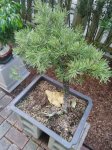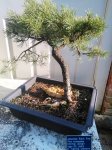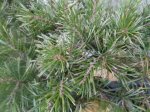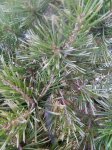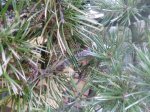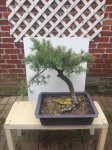You are using an out of date browser. It may not display this or other websites correctly.
You should upgrade or use an alternative browser.
You should upgrade or use an alternative browser.
My first JBP!!
- Thread starter ohiogrown
- Start date
I agree. Looks more like a Scots to me.I see the label and I'm not all that good at IDing trees online, but that sure doesn't look like jbp to me.
Whatever it is, I just hope ohiogrown can make it look nice!
I'm glad you guys said this. I been thinking the same. Needles don't seem to be long enough. But I bought it from a conservatory and they had that tag and everything when they had it on display. I figured they would know what they were talking about. If anyone else has any input I'd love to hear. Also I can take more pictures if it will help. Also would that change the value of the tree?
augustine
Chumono
It also looks like Scots to me. I don't think the value changes. On the plus side Scots is more cold hardy so maybe it will be better in your area depending on how cold it is.
Not to diminish the JBP, which is a lovely tree for bonsai, there are two professionals in my area, Julian Adams and Martha Meehan, who endorse Scots for our part of the world which is the Mid-Atlantic. They are strong, responsive to bonsai techniques and (generally) have shorter needles that JBP.
Either way it's good.
Not to diminish the JBP, which is a lovely tree for bonsai, there are two professionals in my area, Julian Adams and Martha Meehan, who endorse Scots for our part of the world which is the Mid-Atlantic. They are strong, responsive to bonsai techniques and (generally) have shorter needles that JBP.
Either way it's good.
Can someone please tell me what I'm doing wrong already? This thing was in a hot car for several hours the day I got it. The tips seem to be turning light colored. What should I do?
Attachments
Vin
Imperial Masterpiece
I am not a Pine person but it doesn't look good at all. I'm sure someone with pines can offer some insight. Good luck.
thomas rooks
Seedling
- Messages
- 16
- Reaction score
- 15
No matter what species the tree is it has potential, take care of it and enjoy it. Nice Tree
Leo in N E Illinois
The Professor
- Messages
- 11,341
- Reaction score
- 23,294
- USDA Zone
- 5b
Can someone please tell me what I'm doing wrong already? This thing was in a hot car for several hours the day I got it. The tips seem to be turning light colored. What should I do?
I've transported many a plant in my car, trees, orchids, whatever, from Houston, TX to Atlanta GA to Minneapolis MN, all around the greater midwest. Just as you would not leave a dog or child in a closed up car in the hot sun, you can not expect a tree to fare any better. Plant tissue will die at some temperature above 110 F, and a locked car can get quite a bit hotter than that. Desert plants transpire moisture to keep their tissues cooler than about 110 F, in a locked car, there is no air movement to help cool the plant tissues. The exact temperature that will kill a plant varies with species, but somewhere around 110 F just about everything begins to have serious damage. Some orchids will expire at 90 F. so results will vary. There is nothing that can be done other than set the tree in the shade, water it well, and see if the damage progresses, or seems to stop. Put back in 'normal' sun, full sun for pines, if the damage seems to stop progressing.
P. cembroides is the Mexican Pinyon pine. Native to 5000 ft to 8000 ft regions of Mexico, with limited distribution in Tx, NM, and AZ. I doubt it would survive an Ohio winter if we had a normal to colder than normal winter. It is from relatively high elevation, so it will take some cold, but how much requires more research, which I haven't done. It in theory should be good for bonsai. Some have used the USA native species, like P. edulis, the Colorado Pinyon, to good effect. But there has not be a large number of pinyon pines at bonsai shows. There are a dozen or so species in the Pinyon pine group, some are quite rare, most have medium length needles. A few species have very long needles. A group worth exploring, especially if you live in their native range and can collect old yamadori. Worth growing if it turns out that is your tree.
How is the tree now? Has the needle browning progressed?
Thanks for the info. It did progress a little bit has now stopped. I bought the tree from a conservatory in Columbus Ohio. So they have had the tree for a few years. Rather or not they kept it in a green house I don’t know. The research I did was mixed about it being in cold cold weather. But I felt like it was going to be okay. But now that ur saying this makes Me want to do more research. I will get you some more pictures of how it progressed tomorrow. Tonight is supposed to be the first frost of the year. I’m thinking of moving it into my shed. Here are some from two weeks ago. I’ll get better ones of the needles though.I've transported many a plant in my car, trees, orchids, whatever, from Houston, TX to Atlanta GA to Minneapolis MN, all around the greater midwest. Just as you would not leave a dog or child in a closed up car in the hot sun, you can not expect a tree to fare any better. Plant tissue will die at some temperature above 110 F, and a locked car can get quite a bit hotter than that. Desert plants transpire moisture to keep their tissues cooler than about 110 F, in a locked car, there is no air movement to help cool the plant tissues. The exact temperature that will kill a plant varies with species, but somewhere around 110 F just about everything begins to have serious damage. Some orchids will expire at 90 F. so results will vary. There is nothing that can be done other than set the tree in the shade, water it well, and see if the damage progresses, or seems to stop. Put back in 'normal' sun, full sun for pines, if the damage seems to stop progressing.
P. cembroides is the Mexican Pinyon pine. Native to 5000 ft to 8000 ft regions of Mexico, with limited distribution in Tx, NM, and AZ. I doubt it would survive an Ohio winter if we had a normal to colder than normal winter. It is from relatively high elevation, so it will take some cold, but how much requires more research, which I haven't done. It in theory should be good for bonsai. Some have used the USA native species, like P. edulis, the Colorado Pinyon, to good effect. But there has not be a large number of pinyon pines at bonsai shows. There are a dozen or so species in the Pinyon pine group, some are quite rare, most have medium length needles. A few species have very long needles. A group worth exploring, especially if you live in their native range and can collect old yamadori. Worth growing if it turns out that is your tree.
How is the tree now? Has the needle browning progressed?
Attachments
twisted trees
Omono
I tried a small collected pinyon pine in my zone 5 area. It stayed green for two years and never grew roots. I gave up.
miker
Chumono
Nice, natural looking tree.
On the subject of cold hardiness in pine species not native to far northern areas...I bought a Pinus clausa, sand pine last year. This species is native only to Central FL and a few areas of the Deep South right along the coast. I brought the tree with me when I moved to SE Pennsylvania last fall and it over-wintered beautifully with just the pot munched into an egg crate of mulch. Other than that, no protection at all. Same with my JBP.
Being a pine, I suspected it would do just fine being over wintered with other trees.
This is not to say that every species of pine (Pinus) on earth can take a zone 6 or 7 winter, but in my experience, most you will come across can survive outdoors with proper protection, especially in zone 7.
Pinyon pine is native to Mexico, but also to New Mexico, Arizona, Utah and Colorado, and as such, it is unlikely that this species is a cold weather wimp. If I were you, I would place it in a somewhat shaded area (elevated a bit off the ground to avoid drainage issues) just before the first temps below 25F hit and mulch around the pot to protect the roots. Leave it there until spring arrives.
On the subject of cold hardiness in pine species not native to far northern areas...I bought a Pinus clausa, sand pine last year. This species is native only to Central FL and a few areas of the Deep South right along the coast. I brought the tree with me when I moved to SE Pennsylvania last fall and it over-wintered beautifully with just the pot munched into an egg crate of mulch. Other than that, no protection at all. Same with my JBP.
Being a pine, I suspected it would do just fine being over wintered with other trees.
This is not to say that every species of pine (Pinus) on earth can take a zone 6 or 7 winter, but in my experience, most you will come across can survive outdoors with proper protection, especially in zone 7.
Pinyon pine is native to Mexico, but also to New Mexico, Arizona, Utah and Colorado, and as such, it is unlikely that this species is a cold weather wimp. If I were you, I would place it in a somewhat shaded area (elevated a bit off the ground to avoid drainage issues) just before the first temps below 25F hit and mulch around the pot to protect the roots. Leave it there until spring arrives.
This being my first year of bonsai and my first winter I’m not sure of everything yet. I have a un heated little shed, would it be possible to just put all my trees in there just like they are? Or should I actually put them I’m some kind of box with the mulch too?Nice, natural looking tree.
On the subject of cold hardiness in pine species not native to far northern areas...I bought a Pinus clausa, sand pine last year. This species is native only to Central FL and a few areas of the Deep South right along the coast. I brought the tree with me when I moved to SE Pennsylvania last fall and it over-wintered beautifully with just the pot munched into an egg crate of mulch. Other than that, no protection at all. Same with my JBP.
Being a pine, I suspected it would do just fine being over wintered with other trees.
This is not to say that every species of pine (Pinus) on earth can take a zone 6 or 7 winter, but in my experience, most you will come across can survive outdoors with proper protection, especially in zone 7.
Pinyon pine is native to Mexico, but also to New Mexico, Arizona, Utah and Colorado, and as such, it is unlikely that this species is a cold weather wimp. If I were you, I would place it in a somewhat shaded area (elevated a bit off the ground to avoid drainage issues) just before the first temps below 25F hit and mulch around the pot to protect the roots. Leave it there until spring arrives.
miker
Chumono
As it is your first year of bonsai, you probably are not sure about what the temperatures tend to be in your unheated side shed compared to outside during the winter. Ideally, temperatures where you keep your trees should be between 25F and 45F during the winter months, to keep the trees cold enough to stay dormant but also to keep the roots from getting damaged by temps below 25F. How much winter sun exposure does your shed get in the winter? If shaded, that should be perfect for your trees. If it gets a lot of sun, however, the structure will probably get too warm on many winter days to keep your trees dormant.
Once you have some sunny days in the 30s and 40s this November and December, place one or more temperature sensors in your shed and one in the shade outside on these days and see if your shed sees high temperatures similar to what the highs outside are. If so, then your shed should be an excellent winter shelter for your trees. If your highs in the shed are, say, 1-4F higher than outdoor highs, you should still be okay, because that should still mean average winter highs in the shed in your location should be under about 45F. If your shed gets 5F+ warmer than outside on sunny winter days, it is not going to be a good winter home for bonsai.
Note, even if your shed temperatures are good for your trees, you may still have to open the doors during warm spells to keep temperatures down. Also, you may want to put a space heater connected to a thermostat so it automatically kicks in when temperatures get below 20-25F(and set so the heater shuts off when the heater gets temperatures back up to 30F).
Once you have some sunny days in the 30s and 40s this November and December, place one or more temperature sensors in your shed and one in the shade outside on these days and see if your shed sees high temperatures similar to what the highs outside are. If so, then your shed should be an excellent winter shelter for your trees. If your highs in the shed are, say, 1-4F higher than outdoor highs, you should still be okay, because that should still mean average winter highs in the shed in your location should be under about 45F. If your shed gets 5F+ warmer than outside on sunny winter days, it is not going to be a good winter home for bonsai.
Note, even if your shed temperatures are good for your trees, you may still have to open the doors during warm spells to keep temperatures down. Also, you may want to put a space heater connected to a thermostat so it automatically kicks in when temperatures get below 20-25F(and set so the heater shuts off when the heater gets temperatures back up to 30F).
Thanks for the great info! I did go by a wireless temperature gauge so I can start monitoring the temperature. Where would I find a thermostat for a space heater like that?As it is your first year of bonsai, you probably are not sure about what the temperatures tend to be in your unheated side shed compared to outside during the winter. Ideally, temperatures where you keep your trees should be between 25F and 45F during the winter months, to keep the trees cold enough to stay dormant but also to keep the roots from getting damaged by temps below 25F. How much winter sun exposure does your shed get in the winter? If shaded, that should be perfect for your trees. If it gets a lot of sun, however, the structure will probably get too warm on many winter days to keep your trees dormant.
Once you have some sunny days in the 30s and 40s this November and December, place one or more temperature sensors in your shed and one in the shade outside on these days and see if your shed sees high temperatures similar to what the highs outside are. If so, then your shed should be an excellent winter shelter for your trees. If your highs in the shed are, say, 1-4F higher than outdoor highs, you should still be okay, because that should still mean average winter highs in the shed in your location should be under about 45F. If your shed gets 5F+ warmer than outside on sunny winter days, it is not going to be a good winter home for bonsai.
Note, even if your shed temperatures are good for your trees, you may still have to open the doors during warm spells to keep temperatures down. Also, you may want to put a space heater connected to a thermostat so it automatically kicks in when temperatures get below 20-25F(and set so the heater shuts off when the heater gets temperatures back up to 30F).
Figured I’d show you what i found. I think the tree will be okay don’t you?I've transported many a plant in my car, trees, orchids, whatever, from Houston, TX to Atlanta GA to Minneapolis MN, all around the greater midwest. Just as you would not leave a dog or child in a closed up car in the hot sun, you can not expect a tree to fare any better. Plant tissue will die at some temperature above 110 F, and a locked car can get quite a bit hotter than that. Desert plants transpire moisture to keep their tissues cooler than about 110 F, in a locked car, there is no air movement to help cool the plant tissues. The exact temperature that will kill a plant varies with species, but somewhere around 110 F just about everything begins to have serious damage. Some orchids will expire at 90 F. so results will vary. There is nothing that can be done other than set the tree in the shade, water it well, and see if the damage progresses, or seems to stop. Put back in 'normal' sun, full sun for pines, if the damage seems to stop progressing.
P. cembroides is the Mexican Pinyon pine. Native to 5000 ft to 8000 ft regions of Mexico, with limited distribution in Tx, NM, and AZ. I doubt it would survive an Ohio winter if we had a normal to colder than normal winter. It is from relatively high elevation, so it will take some cold, but how much requires more research, which I haven't done. It in theory should be good for bonsai. Some have used the USA native species, like P. edulis, the Colorado Pinyon, to good effect. But there has not be a large number of pinyon pines at bonsai shows. There are a dozen or so species in the Pinyon pine group, some are quite rare, most have medium length needles. A few species have very long needles. A group worth exploring, especially if you live in their native range and can collect old yamadori. Worth growing if it turns out that is your tree.
How is the tree now? Has the needle browning progressed?
www.forestry.ok.gov/Websites/forestry/Images/trees,pinepinyon.pdf
Leo in N E Illinois
The Professor
- Messages
- 11,341
- Reaction score
- 23,294
- USDA Zone
- 5b
Figured I’d show you what i found. I think the tree will be okay don’t you?
www.forestry.ok.gov/Websites/forestry/Images/trees,pinepinyon.pdf
Okay, give it a try. I know my seedling Colorado pinyon take Chicago winters just fine. Wasn't sure its southern cousin would do well too. They do come from high enough elevation that they should have some cold tolerance.
A few weeks have gone by, how is your tree doing? My impression from the pictures is that it would be ok.
It seems to be doing well! There are a few brown needles and needle tips but it’s not progressing. Just heat damage from the summer when I had it in the car too long.
Similar threads
- Replies
- 3
- Views
- 121
- Replies
- 12
- Views
- 388

